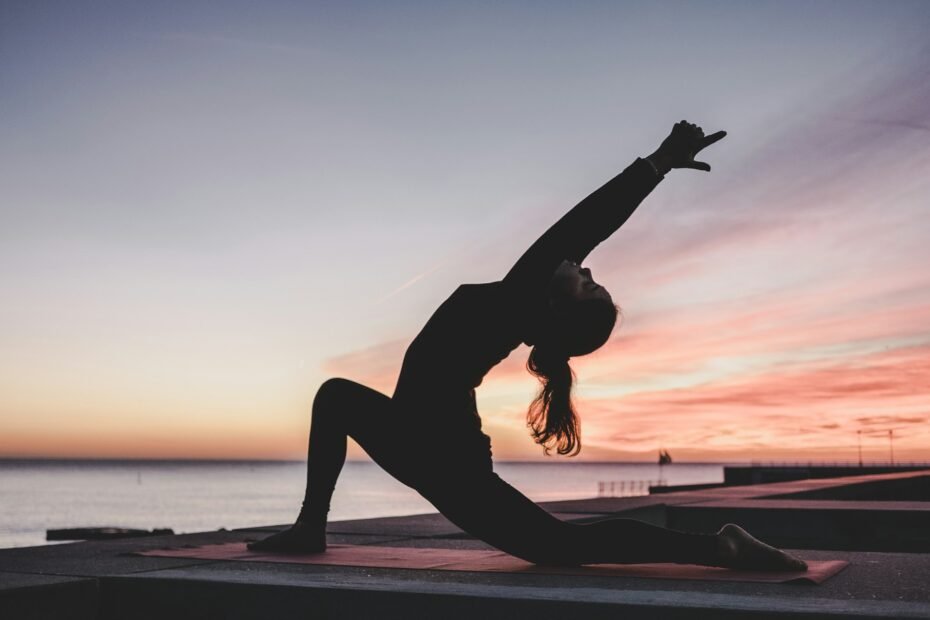In the quiet hours of the morning, amidst the soft hum of a waking world, Maya stepped onto her yoga mat. For months, each step had been a reminder of her struggle with plantar fasciitis, a condition that had turned her morning jogs into a painful ordeal. Desperate for relief, she turned to yoga for plantar fasciitis, skeptical yet hopeful. As she moved through poses designed to stretch and strengthen her foot, a sense of calm enveloped her, not just physically, but mentally too. It was in this moment of tranquility that Maya discovered the true healing power of yoga, not just as a physical practice, but as a holistic approach to wellbeing.
This story mirrors the experience of many who suffer from plantar fasciitis and have found solace in yoga—a gentle, yet effective way to manage the pain and discomfort associated with this condition.
The Role of Yoga in Managing Plantar Fasciitis
Yoga can play a significant role in managing and alleviating the symptoms of plantar fasciitis. It offers a holistic approach to pain relief and healing, targeting not only the physical symptoms but also the underlying causes of the condition.
Through the practice of specific yoga poses, stretches, and exercises, yoga therapy for plantar fasciitis can help improve flexibility, strengthen the muscles and connective tissues in the feet and ankles, including the Achilles tendon, and promote overall foot health.
Incorporating yoga into your daily routine is a great way to prevent and treat common sports injuries like plantar fasciitis and Achilles tendinitis.
One of the key benefits of yoga for plantar fasciitis is the focus on stretching and lengthening the plantar fascia, reducing inflammation and promoting healing. Additionally, yoga poses help improve blood circulation, which can aid in the delivery of nutrients and oxygen to the affected area, further supporting the healing process.
By incorporating yoga into your treatment plan, you can complement other treatment technologies, such as physical therapy or orthotic devices, for plantar fasciitis relief.
The appropriate treatment options may vary depending on the severity and individual needs, so it’s essential to work with a healthcare professional to develop a comprehensive and personalized plan.
Yoga Poses to Alleviate Plantar Fasciitis
Now, let’s explore some specific yoga poses that can help alleviate the symptoms of plantar fasciitis and promote foot health. By incorporating these poses into your regular yoga practice, and focusing on proper alignment and technique, you can experience relief and support the healing process of your plantar fascia.
Foot and Ankle Warmups
Before diving into the yoga poses, it’s important to start with foot and ankle warmup exercises to prepare your feet for practice. These gentle movements help increase blood flow, warm up the muscles, and promote flexibility in the feet and ankles. Consider incorporating the following foot and ankle warmups, including movements in the opposite direction, into your yoga class for plantar fasciitis relief:
- Ankle circles: Sit comfortably and extend one leg forward. Rotate your ankle in a circular motion, both clockwise and counterclockwise, for several rounds. Repeat on the other side.
- Toe stretches: Sit comfortably and interlace your fingers with your toes. Gently spread your toes apart, then release. Repeat this stretch for several rounds to increase flexibility in the toes and feet.
- Calf stretches: Stand facing a wall, and place your hands on the wall for support. Step one foot back, keeping the heel on the ground, and lean forward to feel a stretch in the calf of the extended leg. Hold for several breaths, then switch legs.
- These foot and ankle warmups help prepare the feet for the yoga poses that follow, ensuring a safe and effective practice for plantar fasciitis relief.

Reclining Hand-to-Foot Pose (Supta Padangusthasana)
One of the yoga poses that can provide relief for plantar fasciitis is the Reclining Hand-to-Foot Pose, also known as Supta Padangusthasana. This pose stretches the calf muscles and the arch of the foot, targeting the areas often affected by plantar fasciitis.
To practice Supta Padangusthasana, follow these steps:
- Lie flat on your back with your legs extended.
- Bend your right knee and draw it towards your chest, interlacing your fingers around the sole of your right foot.
- Straighten your right leg, flexing your foot and extending it towards the ceiling.
- Press your left leg firmly into the mat to stabilize your hips and lower back.
- Hold the pose for several breaths, feeling the stretch in your calf and the bottom of your right foot.
- Repeat on the other side, bending your left knee and stretching your left leg.
- Supta Padangusthasana is a gentle yoga pose that can help alleviate tension and tightness in the arches of the feet, as well as provide relief for plantar fasciitis pain.

Toe Pull from Thread-the-Needle Pose (Urdhva Mukha Pasasana)
Another yoga pose that can help with plantar fasciitis relief is the Toe Pull from Thread-the-Needle Pose, also called Urdhva Mukha Pasasana. This pose targets the plantar fascia and stretches the arches of the feet, providing relief for tension and tightness.
To practice Toe Pull from Thread-the-Needle Pose, follow these steps:
- Start in a tabletop position, with your hands and knees on the mat, and your palms and knees shoulder-width apart.
- Slide your right knee behind your left knee, bringing your right foot to the left side of your left knee.
- Extend your left leg straight back, keeping your toes tucked under.
- Sit back on your right heel and gently pull your left toes towards your body, feeling a stretch in the arch of your left foot.
- Hold the pose for several breaths, then switch sides, sliding your left knee behind your right knee and pulling your right toes towards your body.
- Toe Pull from Thread-the-Needle Pose is an effective yoga pose for plantar fasciitis, as it stretches and elongates the plantar fascia, relieving tension and promoting healing.

Upward Salute (Urdhva Hastasana)
Upward Salute, or Urdhva Hastasana, is a yoga pose that stretches the soles of the feet and the calf muscles, offering relief for plantar fasciitis pain and discomfort. This pose is often incorporated in yoga sequences for foot health and can support the healing process of the plantar fascia.
To practice Upward Salute, follow these steps:
- Stand tall with your feet hip-width apart, arms by your sides.
- Inhale and reach your arms overhead, palms facing each other, and your gaze forward.
- Lift your heels and come up onto the balls of your feet, stretching the soles of your feet.
- Engage your calf muscles and feel the stretch through your feet, as you lengthen your spine and open your chest.
- Hold the pose for several breaths, then lower your heels and release your arms to your sides.
- Upward Salute can help improve flexibility in the feet and calf muscles, providing relief for plantar fasciitis symptoms and promoting foot health.

Savasana with Feet Against Wall
Savasana, or Corpse Pose, is a relaxing and restorative yoga pose that can be modified for plantar fasciitis relief. By placing your feet against the wall, you can further support the healing process and release tension in the feet and calf muscles.
To practice Savasana with Feet Against Wall, follow these steps:
- Find a clear wall space and sit next to it, with your right side against the wall.
- Lie down on your back and swing your legs up the wall, so your feet and calves rest against the wall.
- Close your eyes and let your arms relax by your sides, palms facing up.
- Relax your entire body, focusing on your breath and the sensations in your feet and lower legs.
- Stay in this pose for several minutes, allowing your body to fully relax and rejuvenate.
- Savasana with Feet Against Wall can help to alleviate plantar fasciitis pain, promote relaxation, and support the healing process of the plantar fascia.
Further Techniques for Plantar Fasciitis Relief
In addition to the yoga poses mentioned above, there are other techniques and practices that can provide relief and support the healing of plantar fasciitis. Here are a few additional yoga-inspired techniques to incorporate into your plantar fasciitis treatment plan:

Calf Stretch from Staff Pose (Dandasana)
Calf stretches are beneficial for plantar fasciitis relief, as they target the calf muscles, which are connected to the plantar fascia. One effective calf stretch is the Calf Stretch from Staff Pose, or Dandasana.
To practice the Calf Stretch from Staff Pose, follow these steps:
- Sit on the floor with your legs extended in front of you, toes pointing up.
- Place your hands on the floor slightly behind your hips, fingers pointing towards your feet.
- Engage your thigh muscles and press your heels down, feeling the stretch in your calves.
- Hold the pose for several breaths, then relax and repeat as desired.
- The Calf Stretch from Staff Pose helps to lengthen and stretch the calf muscles, providing relief for plantar fasciitis symptoms and supporting the healing process.
Yogic Foot Massage Techniques
Yogic foot massage techniques can be used as a complementary practice to yoga poses to further relieve plantar fasciitis pain and discomfort. By incorporating gentle massage and self-care practices, you can support the healing of the plantar fascia and promote overall foot health.
Working with a yoga therapist or studying specific plantar fasciitis yoga cure techniques can help you learn effective foot massage techniques and enhance your healing process.

Chair Pose (Utkatasana)
Chair pose, also known as Utkatasana, is a powerful yoga pose that can help strengthen the feet and ankle muscles. By engaging the muscles of the feet and lower legs, you can support the arches of the feet and provide relief for plantar fasciitis pain and discomfort.
To practice Chair Pose, follow these steps:
- Stand tall with your feet hip-width apart, toes pointing forward.
- Inhale and raise your arms overhead, palms facing each other.
- Exhale and bend your knees, as if sitting back into an imaginary chair, keeping your weight in your heels.
- Engage your feet and ankle muscles, and lengthen your spine as you lift your chest.
- Hold the pose for several breaths, then slowly stand up to release.
- Chair pose helps to develop stability and balance, crucial for foot health, and can provide relief for plantar fasciitis symptoms.

Tabletop to Toe Pose
Tabletop to Toe pose is an effective yoga stretch for plantar fasciitis, as it targets the soles of the feet and the arches, providing relief for pain and discomfort.
To practice Tabletop to Toe pose, follow these steps:
- Begin in a tabletop position, with your hands and knees on the mat, and your palms and knees shoulder-width apart.
- Curl your toes under, as you shift your hips back towards your heels, sitting on your feet.
- To deepen the stretch, carefully lift your knees off the mat, balancing on your toes and the balls of your feet, keeping your hand support on the mat.
- Hold the pose for several breaths, feeling the stretch in the soles of your feet and the arches.
- To release, lower your knees back to the mat and sit back on your heels.
- Tabletop to Toe pose helps to stretch and strengthen the feet and ankle muscles, providing relief for plantar fasciitis symptoms and promoting foot health.
Daily Practices to Prevent Plantar Fasciitis
To prevent the onset or recurrence of plantar fasciitis, it is essential to incorporate daily practices into your routine that support foot health and overall well-being. By maintaining healthy habits and taking proactive measures, you can reduce the risk of developing plantar fasciitis and promote healthy aging of the feet.
Importance of Proper Footwear
Wearing appropriate footwear is crucial for preventing plantar fasciitis and supporting foot health. Invest in shoes that provide arch support, cushioning, and proper alignment for your feet. If you have high arches, look for shoes with extra arch support to help distribute weight evenly and reduce strain on the plantar fascia.
Avoid wearing unsupportive shoes, such as flip-flops or high heels, for extended periods. Additionally, for those suffering from plantar fasciitis, it is recommended to wear night splints or boots that hold the feet in dorsiflexion while sleeping to help counter the condition and promote healing.
Regular Foot and Ankle Exercises
Incorporating regular foot and ankle exercises into your routine can help strengthen the muscles and connective tissues in the feet, reduce the risk of plantar fasciitis, and support overall foot health. Consider the following exercises to improve foot strength and flexibility:
- Toe curls: Sit comfortably and place a small towel on the floor in front of you. Use your toes to grip and curl the towel toward you, then release. Repeat for several rounds.
- Pilates footwork: Lie on your back with your legs extended, and place a resistance band across the ball of your right foot. Flex and point your foot, stretching the band. Repeat on the left foot.
- Ankle rolls: Sit comfortably and extend one leg in front of you. Rotate your ankle in a circular motion, both clockwise and counterclockwise, for several rounds. Switch legs and repeat.
- Yoga poses for foot health: Incorporate yoga poses that target the feet, such as toe stretches, arch lifts, and ankle rotations, into your regular yoga practice.
- Remember to consult with a healthcare professional or yoga therapist for guidance and modifications based on your specific needs and limitations.

Adequate Rest and Recovery Periods
Giving your feet adequate rest and recovery periods is crucial for preventing plantar fasciitis and supporting the healing process if you are already experiencing symptoms. Here are some tips for incorporating rest and recovery into your routine:
- Listen to your body and take breaks when needed, especially during high-intensity activities or prolonged periods of standing.
- Elevate your feet and apply ice, if necessary, to reduce inflammation and relieve pain.
- Prioritize quality sleep to support overall tissue healing and rejuvenation.
- Consider alternate forms of low-impact exercises, such as swimming or cycling, to give your feet and plantar fascia a break.
- By practicing regular foot and ankle exercises, resting when needed, and prioritizing healthy recovery practices, you can help prevent plantar fasciitis and maintain foot health.
Success Stories: Overcoming Plantar Fasciitis with Yoga
Many individuals have successfully overcome plantar fasciitis and found relief through the practice of yoga. These success stories highlight the effectiveness of yoga poses and therapy for plantar fasciitis relief, as well as improved foot health and overall well-being.
Tips for Staying Motivated Throughout the Healing Process
Staying motivated throughout the healing process is essential for long-term relief from plantar fasciitis pain and discomfort. Here are some tips to help you stay motivated and committed to your healing journey:
- Set realistic goals and be patient with your progress. Healing takes time, and results may not be immediate.
- Find a support system, whether it’s a yoga community, support group, or a yoga therapist who can provide guidance and encouragement.
- Keep a journal to track your progress, reflect on challenges, and celebrate milestones along the way.
- Focus on the benefits of healing, such as decreased pain, increased mobility, and improved overall foot health.
- Mix up your yoga routine to keep it exciting and challenging. Explore different poses, sequences, and yoga styles to prevent boredom and monotony.
- Remember, healing is a lifelong journey, and committing to your yoga practice and healthy habits can lead to long-term relief and improved well-being.
How Frequently Should You Practice Yoga for Plantar Fasciitis Relief?
The frequency of your yoga practice for plantar fasciitis relief will depend on various factors, including your individual needs, schedule, and overall commitment to your healing journey. Here are some general guidelines to help you determine how often to practice yoga for plantar fasciitis relief:
- Aim to practice yoga at least 3-4 times per week to benefit from its healing effects. Consistency is key for long-term relief and improvement.
- Each yoga session should ideally last for about 20-30 minutes to allow your body and plantar fascia to experience the desired benefits.
- Be mindful of your body and listen to its needs. If you feel discomfort or pain during or after yoga, consider reducing the frequency or intensity of your practice and consult with a healthcare professional for guidance.
- Additionally, incorporating daily foot exercises, stretches, and self-care practices, as well as proper rest and recovery, can further support the healing process of plantar fasciitis and overall foot health.
- Maintaining a regular yoga practice, combined with other healthy lifestyle habits, can help you manage and alleviate the symptoms of plantar fasciitis, as well as reduce the risk of future occurrences.

How often should I practice yoga for plantar fasciitis?
To maximize the benefits of yoga for plantar fasciitis, it is recommended to practice at least 3-4 times a week. Consistency is key in healing and preventing further injury. Remember to listen to your body and adjust the frequency and intensity of your practice as needed. Incorporate poses that stretch and strengthen the feet, ankles, and calves, including gentle movements to lift and support the inner arches of the feet with the help of your right hand.
Are there any precautions I should take while doing yoga with plantar fasciitis?
Precautions while practicing yoga with plantar fasciitis include consulting a doctor, avoiding poses that strain the feet, using props to modify poses, and taking breaks if there is discomfort.
Can yoga replace other forms of treatment for plantar fasciitis or should it be used in conjunction with other treatments?
Yoga can be a beneficial complementary treatment for plantar fasciitis, but it should not replace other forms of treatment, especially in severe cases. Physical therapy and medication may still be necessary, and speaking to your doctor right away is highly recommended to avoid complications and severe heel pain. Yoga can help improve flexibility and strengthen the muscles in the feet and legs, but consulting with a healthcare professional is important for an integrated treatment plan.

Conclusion
Yoga is not just a practice for the mind and soul; it’s also a powerful tool for physical healing. For sufferers of plantar fasciitis, it offers a gentle yet effective way to manage pain, improve mobility, and enhance quality of life. As we continue to explore and embrace the healing powers of yoga, we open ourselves to a world of pain-free possibilities. Have you considered how yoga could be the key to unlocking your path to recovery?
I hope you found this blog helpful and please feel free to comment and share.
Thanks for reading!
 | Tracy J. Founder, The heel GP |
